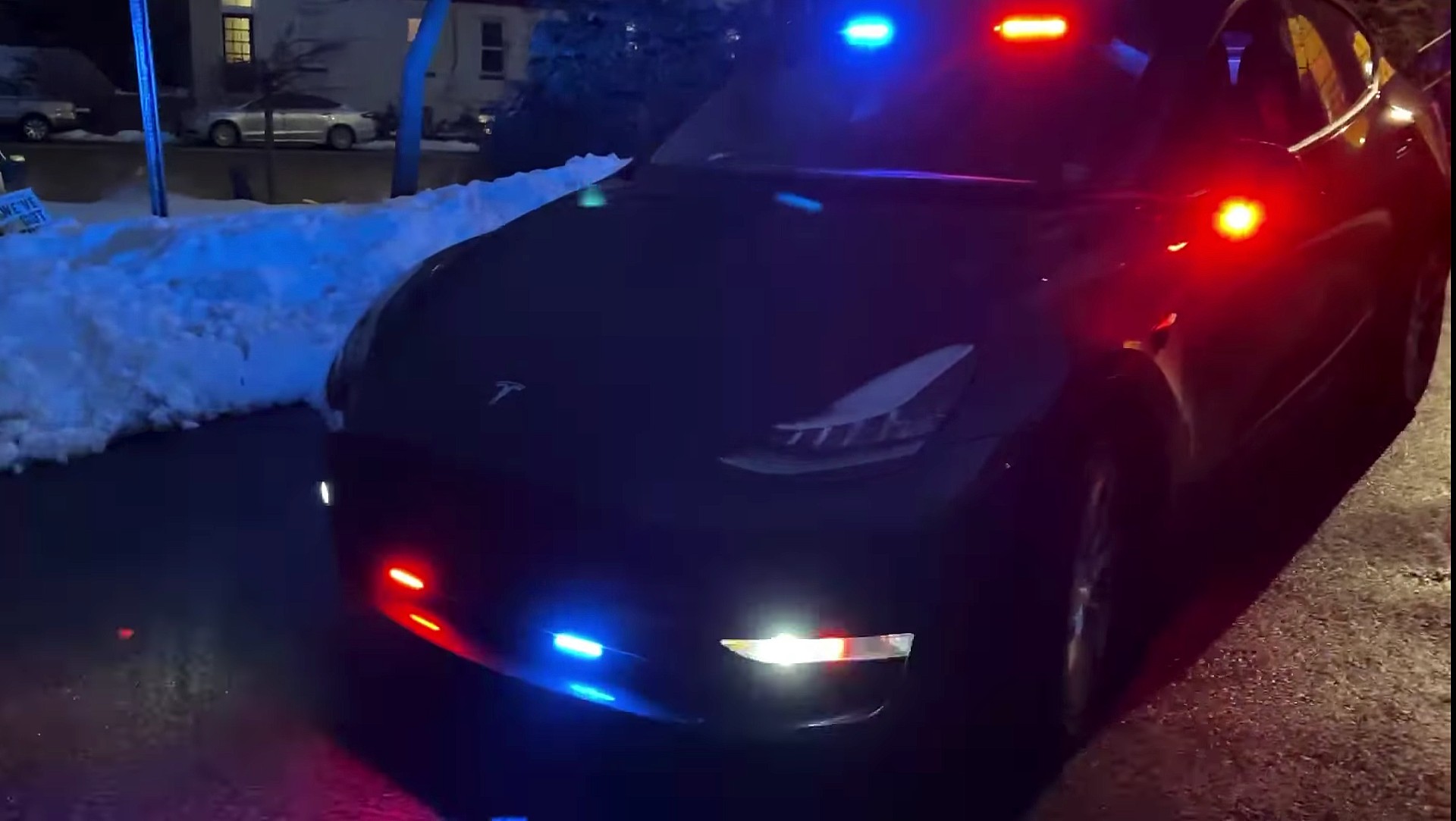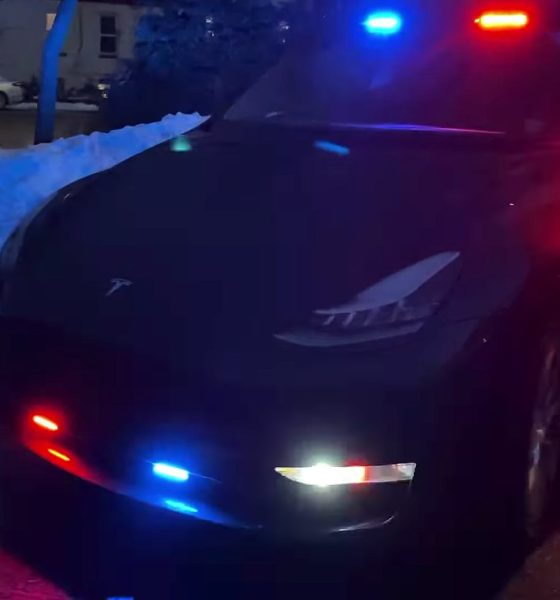

News
Tesla Model Y police cruiser draws criticism from taxpayers
The Tesla Model Y police cruiser, which joined the Hastings on Hudson, New York Police Department in late December, is receiving criticism from taxpayers. Unfortunately, many of those who have expressed their concerns about the vehicle’s cost are not fully aware of the long-term savings that the Model Y will give taxpayers and the police department.
The Hastings on Hudson PD posted a video of their new Model Y crossover, equipped with flashing red and blue lights and the necessary equipment for an officer of the law. It was the first-ever Model Y to be used as a police cruiser, and the Department indicated that the all-electric crossover would serve “as the police car assigned to the Detective Division.”
Despite the environmental and long-term cost-effectiveness of the Tesla, many Social Media users were critical of the Department’s choice to purchase the car in place of the traditional Dodge Charger cruiser that many forces across the country have utilized for transportation. The widespread idea that Teslas are only affordable by the rich and famous is still presently being used as an argument based on what Twitter users are saying, even though the automaker has been able to release the Model 3 and Model Y at price points that are affordable for many people. The price alone, along with the industry-leading battery tech and performance of Tesla’s cars, is what has made them the most popular EVs in the United States and China.
One Twitter user gained over 46,000 Retweets and over 172,000 Likes by stating, “This is gonna be parked outside of a public school with a paper shortage, old textbooks, and one computer per classroom.”
A user on Facebook replied to the Hastings on Hudson PD’s Facebook post directly, saying, “DEFUND THE POLICE! Why is this needed?”
The problem with making statements like those above is that the price comparison of the Model Y to a traditional Dodge Charger is not all that different. When factoring in the maintenance and fuel savings that the Department will have in the coming years, the Tesla will be substantially less expensive than the Charger, which will require regular oil changes and maintenance that is more likely to be needed when dealing with a gas car that has so many moving parts.
The cost-effectiveness of driving a Tesla instead of a Charger has already been proven by the Bargersville, Indiana Police Department, who purchased a Model 3 for a cruiser in August 2019. In the first 13 months, the Department saved $6,755 in fuel alone. A Charger, which the Bargersville PD maintained while also operating the Model 3, had a yearly cost of $7,580 for gas and maintenance. The Model 3’s annual cost was only $825.
Actual numbers for 1 year of Tesla model 3 police car pic.twitter.com/lGESk0LgIR
— Todd Bertram (@ToddBertram1) September 29, 2020
Meanwhile, the Dodge Charger Scat Pack, which is a frequently-purchased variant of the vehicle for Police Departments, had an MSRP of $40,500. The Model Y’s Long Range AWD variant starts at just $49,990. Based on the Bargersville PD’s figures, the $9,490 difference would be canceled out in about a year and a half.
While there is plenty of criticism floating around social media because of the Police Department’s choice to purchase a Tesla, the real issue is the consistently spread misinformation. The environmental advantages of driving a Tesla over a powerful, gas-thirsty Charger are enough to convince some, but the long-term savings of going with the EV option are enough to sway even the most critical of skeptics.
What do you think? Leave a comment down below. Got a tip? Email us at tips@teslarati.com or reach out to me at joey@teslarati.com.
H/t: Business Insider

News
Tesla FSD fleet is nearing 7 billion total miles, including 2.5 billion city miles
As can be seen on Tesla’s official FSD webpage, vehicles equipped with the system have now navigated over 6.99 billion miles.

Tesla’s Full Self-Driving (Supervised) fleet is closing in on almost 7 billion total miles driven, as per data posted by the company on its official FSD webpage.
These figures hint at the massive scale of data fueling Tesla’s rapid FSD improvements, which have been quite notable as of late.
FSD mileage milestones
As can be seen on Tesla’s official FSD webpage, vehicles equipped with the system have now navigated over 6.99 billion miles. Tesla owner and avid FSD tester Whole Mars Catalog also shared a screenshot indicating that from the nearly 7 billion miles traveled by the FSD fleet, more than 2.5 billion miles were driven inside cities.
City miles are particularly valuable for complex urban scenarios like unprotected turns, pedestrian interactions, and traffic lights. This is also the difference-maker for FSD, as only complex solutions, such as Waymo’s self-driving taxis, operate similarly on inner-city streets. And even then, incidents such as the San Francisco blackouts have proven challenging for sensor-rich vehicles like Waymos.
Tesla’s data edge
Tesla has a number of advantages in the autonomous vehicle sector, one of which is the size of its fleet and the number of vehicles training FSD on real-world roads. Tesla’s nearly 7 billion FSD miles then allow the company to roll out updates that make its vehicles behave like they are being driven by experienced drivers, even if they are operating on their own.
So notable are Tesla’s improvements to FSD that NVIDIA Director of Robotics Jim Fan, after experiencing FSD v14, noted that the system is the first AI that passes what he described as a “Physical Turing Test.”
“Despite knowing exactly how robot learning works, I still find it magical watching the steering wheel turn by itself. First it feels surreal, next it becomes routine. Then, like the smartphone, taking it away actively hurts. This is how humanity gets rewired and glued to god-like technologies,” Fan wrote in a post on X.
News
Tesla starts showing how FSD will change lives in Europe
Local officials tested the system on narrow country roads and were impressed by FSD’s smooth, human-like driving, with some calling the service a game-changer for everyday life in areas that are far from urban centers.

Tesla has launched Europe’s first public shuttle service using Full Self-Driving (Supervised) in the rural Eifelkreis Bitburg-Prüm region of Germany, demonstrating how the technology can restore independence and mobility for people who struggle with limited transport options.
Local officials tested the system on narrow country roads and were impressed by FSD’s smooth, human-like driving, with some calling the service a game-changer for everyday life in areas that are far from urban centers.
Officials see real impact on rural residents
Arzfeld Mayor Johannes Kuhl and District Administrator Andreas Kruppert personally tested the Tesla shuttle service. This allowed them to see just how well FSD navigated winding lanes and rural roads confidently. Kruppert said, “Autonomous driving sounds like science fiction to many, but we simply see here that it works totally well in rural regions too.” Kuhl, for his part, also noted that FSD “feels like a very experienced driver.”
The pilot complements the area’s “Citizen Bus” program, which provides on-demand rides for elderly residents who can no longer drive themselves. Tesla Europe shared a video of a demonstration of the service, highlighting how FSD gives people their freedom back, even in places where public transport is not as prevalent.
What the Ministry for Economic Affairs and Transport says
Rhineland-Palatinate’s Minister Daniela Schmitt supported the project, praising the collaboration that made this “first of its kind in Europe” possible. As per the ministry, the rural rollout for the service shows FSD’s potential beyond major cities, and it delivers tangible benefits like grocery runs, doctor visits, and social connections for isolated residents.
“Reliable and flexible mobility is especially vital in rural areas. With the launch of a shuttle service using self-driving vehicles (FSD supervised) by Tesla in the Eifelkreis Bitburg-Prüm, an innovative pilot project is now getting underway that complements local community bus services. It is the first project of its kind in Europe.
“The result is a real gain for rural mobility: greater accessibility, more flexibility and tangible benefits for everyday life. A strong signal for innovation, cooperation and future-oriented mobility beyond urban centers,” the ministry wrote in a LinkedIn post.
News
Tesla China quietly posts Robotaxi-related job listing
Tesla China is currently seeking a Low Voltage Electrical Engineer to work on circuit board design for the company’s autonomous vehicles.

Tesla has posted a new job listing in Shanghai explicitly tied to its Robotaxi program, fueling speculation that the company is preparing to launch its dedicated autonomous ride-hailing service in China.
As noted in the listing, Tesla China is currently seeking a Low Voltage Electrical Engineer to work on circuit board design for the company’s autonomous vehicles.
Robotaxi-specific role
The listing, which was shared on social media platform X by industry watcher @tslaming, suggested that Tesla China is looking to fill the role urgently. The job listing itself specifically mentions that the person hired for the role will be working on the Low Voltage Hardware team, which would design the circuit boards that would serve as the nervous system of the Robotaxi.
Key tasks for the role, as indicated in the job listing, include collaboration with PCB layout, firmware, mechanical, program management, and validation teams, among other responsibilities. The role is based in Shanghai.
China Robotaxi launch
China represents a massive potential market for robotaxis, with its dense urban centers and supportive policies in select cities. Tesla has limited permission to roll out FSD in the country, though despite this, its vehicles have been hailed as among the best in the market when it comes to autonomous features. So far, at least, it appears that China supports Tesla’s FSD and Robotaxi rollout.
This was hinted at in November, when Tesla brought the Cybercab to the 8th China International Import Expo (CIIE) in Shanghai, marking the first time that the autonomous two-seater was brought to the Asia-Pacific region. The vehicle, despite not having a release date in China, received a significant amount of interest among the event’s attendees.








